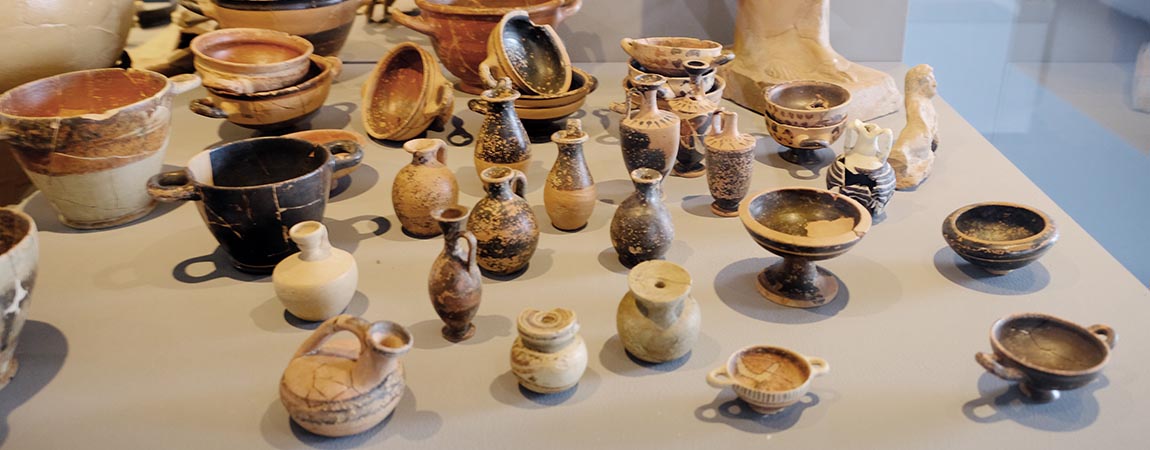
Fans of ancient finds will certainly know the so-called Centuripe Ceramics, also known with the more technical name of polychrome ceramics of eastern Sicily.
These are historical artifacts that date back to a period that can be placed between the XNUMXrd and XNUMXnd century BC and which amazes everyone with the precision of its features. Examples of Centuripe ceramics can be admired both in the homonymous city center in the province of Enna and in other parts of the world: here is all there is to know.
What is Centuripe Pottery
The term Centuripe pottery refers to a series of artifacts that have been made in terracotta and, after their firing, decorated by hand with the polychrome painting technique. Their creation dates back to a period of time ranging from the third to the second century BC and they are defined as Centuripe because they were found in this area which has always been the subject of archaeological excavations given the vastness of finds that have always been hidden in these areas, buried by the layers of time.
This category includes many different types of artifacts such as ceramic masks, centurian vases but also clay statuettes. Many of these finds can be viewed in the Centuripe archaeological museum while others are kept in the collections of other museums around the world.
The History of Centuripe Pottery
Centuripe ceramics have had continuous production over the millennia and the first examples date back to the third century BC, however the attention of scholars is much more recent if it is true that the first to talk about it was Thomas Fazello in one of his writings of the sixteenth century while Jean Houel in the eighteenth century he made a reproduction of it in one of his texts, describing some examples in great detail.
For a more systematic classification of the finds, however, we have to wait for the XNUMXth century when two well-known scholars of the time, Reinhard Kekule von Stradoniz and Désiré-Raoul Rochette, bring Hellenistic terracottas of Centuripine origin to worldwide attention.
Unfortunately, however, the scarcity of funds has prevented extensive excavation campaigns from being carried out for years, thus leaving the way free for the so-called grave robbers who stole numerous and important finds for a long time.
Le Ceramica di Centuripe: technical details
All the artifacts that are classified according to the wording Ceramics of Centuripe have characteristics in common that make them easily recognizable. First of all they are made exclusively in terracotta and the decoration is carried out cold, according to the polychrome pictorial technique or with the application of plastic decorations which are obviously in relief.
As regards the subjects, female figures and Dionysian scenes are privileged, revealing above all a production of a wedding or funerary nature. Finally, as far as colors are concerned, black and white in particular are used, but also pink, gold and ochre, red, less frequently blue and green.
The production of ancient pottery in Centuripe
Centuripe pottery includes different types of artifacts. Among the most famous ones there are certainly the centuripine vases which have a particular pyx shape but there may also be examples of lekanide. These artifacts are in particular decorated with architectural or floral motifs and have a clearly Hellenistic derivation.
Then there are the so-called clay statuettes which were made for funeral purposes and reproduce dancing female figures or divinities or fauns. Starting from the second century BC, however, figures representing animals also begin to appear.
Finally there are the theatrical masks which are produced in large quantities in Centuripe, becoming the second center of creation after Lipari: according to scholars, the Centuripe masks they were created to be worn by actors during theatrical performances, in particular those of the works of Menander and all the new comedy.
Where to admire the Centuripe Pottery
Centuripe Pottery can be seen in all its glory in the archaeological Museum of the locality of the same name within which, starting from the early 1900s, all the artifacts that were found or recovered by the robbers were collected. In particular, on the first floor of the museum are exhibits such as centuripine masks, i lekanis (vessels of circular shape typical of theAncient Greece) and the craters but also the statuettes filiform funeral.
Other specimens can be admired in the archaeological museums of Palermo, Trapani, Syracuse and Rome. Finally there are examples of Centuripe pottery also al Metropolitan Museum of Art in New York, Princeton in New Jersey and to the museum Getty of Los Angeles, just to name a few.
Pottery in Centuripe today
Even today, Centuripe is a very important ceramic production centre, which attracts thousands of visitors every year who wish to be able to buy an example of very fine ceramics to take home or simply discover the secrets of their production.
On the other hand, even if obviously the subjects of the decorations have changed over the millennia as well as the production techniques and the purpose of the ceramics, the attention and love that are used for this particular object remain the same.
© Davide Mauro, CC BY-SA 4.0 https://creativecommons.org/licenses/by-sa/4.0, via Wikimedia Commons









